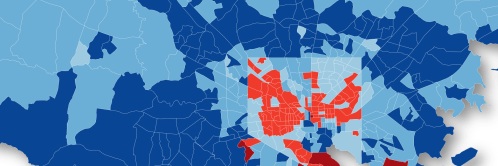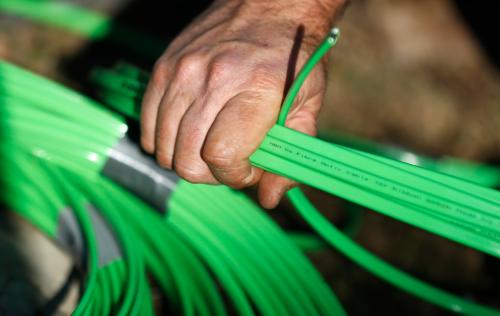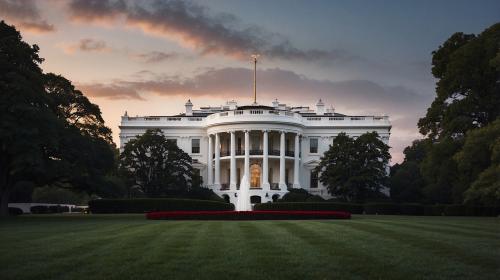Digital connectivity is the glue of the modern American economy. From rural farmers to city business leaders, every industry relies on broadband to track markets, connect with customers, and sell their products. The American household is equally reliant on broadband, whether its kids bringing home their digital classrooms, adults telecommuting to their jobs, or whole families streaming video content to their televisions. And governments at all levels can use digital platforms to improve service delivery and reduce costs.
Click here to explore the broadband subscription and availability map for your district.
Yet for all of broadband’s economic benefits, the country continues to face a significant digital divide at the household level. First, over 22 million people live in neighborhoods without an available broadband connection, defined here as a 25 Mbps download speed via wireline. Second—and maybe more troublingly—over 73 million people live in neighborhoods where subscription rates fall below 40 percent.
Without seamless digital connectivity, many households are at-risk of falling further behind in the country’s advanced economy.
Congress’ concerns: Uneven focus on broadband availability while overlooking subscription
Congress clearly understands the importance of bringing broadband into every home in the country, and continues to make it a priority. The House and Senate held five separate hearings related to broadband connectivity in 2017, and legislators across both parties introduced eight separate bills related to improving broadband’s physical reach and studying its economic impact over the same timeframe. These build on past legislation and direct funding to improve the country’s broadband infrastructure.
Fully tapping into the internet’s economic benefits will require legislators and their staff to also address the country’s subscription gaps.
However, the legislative approach is still under development. While Congress considers policies related to expanding broadband availability, there is little to no legislative activity related to broadband adoption. Fully tapping into the internet’s economic benefits will require legislators and their staff to also address the country’s subscription gaps.
Based on an analysis of all 435 congressional districts, every member stands to benefit from federal policies that boost wireline broadband availability and adoption. Developing bipartisan solutions—especially for Republican members’ constituents, who face the largest broadband gaps—will ensure that every household has a chance to participate in America’s rapidly-evolving digital economy.
Our recent report, Signs of digital distress: Mapping broadband availability and subscription in American neighborhoods, provides in-depth data and visualizations showing where remaining broadband gaps persist throughout the country. This post, however, dives into the data as related to congressional jurisdictions, and provides thoughts for federal policymakers to consider implementing to move the needle on connecting all Americans to the digital economy.
Broadband is widely available across the country, but Republican members of Congress disproportionally represent populations without physical access to high-speed internet. Overall, Republican House members serve districts where 89.4 percent of residents can physically access a wireline broadband connection. The gap equates to nearly 18.6 million people who physically cannot access broadband in their home. By comparison, Democratic House members represent districts with 97.5 percent coverage, leaving a much smaller gap of 3.5 million people.
Availability gaps are especially pronounced in the Central time zone. Rep. Markwayne Mullin (OK-2) represents the only district in the country where broadband is available to less than half the population. There are five other districts where broadband is available to between 50 and 60 percent of their population, all of which are along this central spine (AL-1, MO-8, LA-5, AR-4, MS-3). While Republicans represent most of the low-availability districts, Democratic-represented districts like AZ-1, MS-2, MN-7, and MN-8 also fall into the bottom quintile of availability, each housing over 150,000 people who cannot connect to broadband in their home.
In contrast, 107 districts can boast of broadband availability to every resident. There are another 153 districts where at least 95 percent of the population has physical access. These and other high-availability districts either hug the coasts or represent large metropolitan areas throughout the country. Phoenix, St. Louis, and Kansas City are stark examples of this metropolitan advantage, as their respective districts enjoy broadband availability far outpacing their statewide peers.

Population density is a major driver of broadband availability, disproportionally impacting Republicans who tend to represent less dense districts than their Democratic peers. Density is a crucial component in broadband economics, as more people in a specific place effectively reduces marginal construction costs per potential customer. Overcoming this fundamental economic challenge—whether through cheaper wireline delivery or wireless alternatives—is essential to providing more rural Americans access to broadband speeds.
Broadband economics related to population density tend to more adversely impact Republican-leaning districts. While Democrats represent districts with an average population density of 252 people per square mile, Republicans’ districts average 59 people per square mile.

Low broadband subscription rates are a more pervasive national challenge, and more consistently impact the entire political spectrum. All but 29 districts across the country include at least some neighborhoods that qualify as low subscription, which we define as Census tracts where no more than 40 percent of the population subscribe to in-home broadband. Put another way, nearly every district has significant pockets of digital disconnect.
Republican legislators represent the bulk of these low-subscribing neighborhoods, which house over 51 million people. Many of the largest gaps are the same districts with limited broadband availability. Yet in others, like Rep. Thomas Rooney’s (FL-17) district in south-central Florida and Rep. Doug Collins’ (GA-9) district in north-central Georgia, broadband is widely available but subscribership is low.
Democratic legislators represent over 22 million people who live in low-subscription neighborhoods. In the districts with the biggest subscription gaps, more often than not broadband is widely available. Rep. Lucille Roybal-Allard’s (CA-40) district in east Los Angeles has 100 percent availability, but nearly half-a-million people live in low subscription neighborhoods. Similar subscription challenges in districts with high availability include TX-34, TX-33, and NM-1.

The highest subscription rates are found in districts serving the coasts and large metropolitan areas. Our research finds that higher subscription rates are predominantly found in neighborhoods housing residents with higher incomes and education levels. The largest number of these neighborhoods are often found in metropolitan areas earning high incomes and that concentrate industries which demand a well-educated workforce. It’s no surprise, then, that districts serving these kinds of communities tend to experience the highest subscription rates.
Both political parties serve a relatively equal number of residents in high-subscription neighborhoods, or Census tracts where at least 80 percent of people subscribe. These include suburban districts around New York City, Dallas, Tampa, and Washington, D.C. represented by Republicans. They also include a mix of urban and suburban districts from Boston, to Kansas City, to San Diego. But keep in mind, no congressional district achieves universal subscription among all residents.

Committee leadership is well-positioned to lead on improving broadband availability and adoption. With Republicans holding majorities in both congressional chambers and broadband a core component of national debates around infrastructure investment, their committee leaders have a unique opportunity to set a broadband agenda for years to come.
Many of these committee leaders only need to look to their home districts to see digital challenges facing their constituents. Rep. Marsha Blackburn (TN-4) currently chairs the important House Subcommittee on Communications and Technology, although she is preparing a run for a Senate seat in Tennessee. Broadband does not serve 25 percent of constituents in her home district, while 38 percent of people live in low-subscription neighborhoods. Her subcommittee sits under the Energy and Commerce committee, where Chair Greg Walden (OR-2) represents a district with 44 percent of people living low-subscription neighborhoods. Improved federal broadband policy could make a real difference in their districts.
Similar incentives exist for Senate leadership in relevant committees. Sen. John Thune (SD) chairs the Commerce, Science, and Transportation committee, which includes the Communications, Technology, Innovation, and the Internet subcommittee chaired by Sen. Roger Wicker (MS). South Dakota and especially Mississippi both have pronounced broadband availability and subscription gaps.
| District | Party | Representative | Committee assignment | Broadband availability | Low-subscription share | High-subscription share |
| NJ-06 | D | Frank Pallone, Jr. | Ranking member, House Committee on Energy and Commerce | 100.0% | 0.0% | 44.9% |
| NJ-07 | R | Leonard Lance | Vice chair, House Subcommittee on Communications and Technology | 100.0% | 7.2% | 62.9% |
| OR-02 | R | Greg Walden | Chair, House Committee on Energy and Commerce | 89.0% | 43.5% | 8.0% |
| PA-14 | D | Michael Doyle | Ranking member. House Subcommittee on Communications | 100.0% | 6.8% | 25.1% |
| TN-07 | R | Marsha Blackburn | Chair, House Subcommittee on Communications and Technology | 75.2% | 38.5% | 18.5% |
| TC-06 | R | Joe Barton | Vice chair, House Committee on Energy and Commerce | 94.5% | 17.6% | 8.2% |
The question Congress must add to their broadband docket: how do we boost subscription? As mentioned, Congress deserves credit for continuing to explore the federal role in boosting broadband availability. Tracking how developments in wireless technology could lead to market-driven improvements or studying how tightly-controlled federal subsidies could incentivize service delivery both make sense. As such, currently-proposed legislation moves in this direction.
A potentially trickier, but more geographically diffuse, issue is promoting broadband subscription. Here, the federal role is limited to the Lifeline program subsidizing broadband service, educational and information programs administered by NTIA, and support funneled to community assets like libraries. In fact, the largest national pricing support programs are offered by private companies, like Comcast’s Internet Essentials and Cox’s Connect2Compete. There is also a sentiment that growing smartphone penetration could fill gaps, but smartphones are no substitute for in-home broadband—they’re complements.
Broadband is simply too important to not be present in every American household.
Broadband is simply too important to not be present in every American household. Getting broadband to be as ubiquitous as electricity and water service will require tough conversations about the federal role around digital skills training, pricing support, and how to pay for it. But doing nothing likely means new barriers to opportunity, especially for our youth who have no choice as to whether they live in a home with a broadband subscription. We should not accept that future.
Statistical Notes: The FCC reports broadband availability at the block level, which we aggregate up to the Census tract level. The FCC publishes broadband subscriptions at the Census tract level using population shares by quintile—0 to 20 percent, 20 to 40 percent, and so on. We combine this data with Census ACS data to provide demographic information for each district and the entire country. All data is current as of 2015. The full broadband methodology can be found within the main report.
CONGRESSIONAL DISTRICT MAPS
The Brookings Institution is committed to quality, independence, and impact.
We are supported by a diverse array of funders. In line with our values and policies, each Brookings publication represents the sole views of its author(s).







Commentary
Broadband gaps impact every member of Congress
Tuesday, November 7, 2017